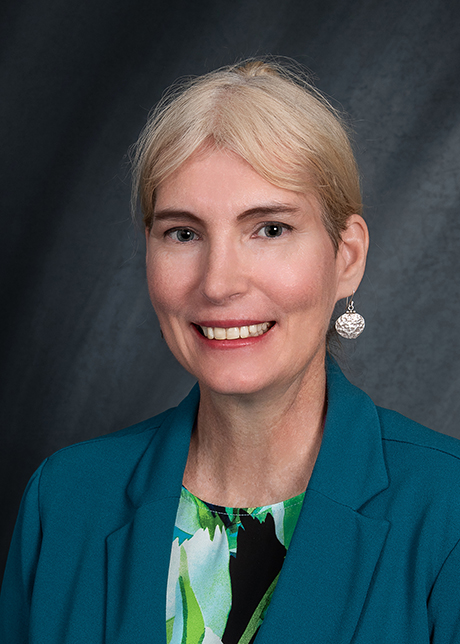
Astrid M. Müller
Assistant Professor of Chemical Engineering
PhD, Max-Planck Institute of Quantum Optics & Ludwig-Maximilians-Universität München, 2000
- Office Location
- 4509 Wegmans Hall
- Telephone
- (585) 276-7331
- Fax
- (585) 273-1348
- Web Address
- Website
Research Overview
Research in the Müller group leverages the tools of pulsed laser assisted nanomaterial fabrication and electrochemical process engineering to design new electrocatalytic systems that address challenges in energy, catalysis, and environmental sustainability. In particular, we concentrate on understanding materials interfaces, electrocatalytic mechanisms, and the role of reactive species from water activation, to enhance reaction selectivity and increase energy efficiency. We develop innovative electrochemical systems for (i) the complete aqueous defluorination of per- and polyfluoroalkyl substances (PFAS), (ii) selective electrooxidation of organic molecules, and (iii) carbon dioxide reduction. Our interdisciplinary research program integrates chemical engineering and materials science, focusing on pulsed laser nanocatalyst synthesis, materials chemistry, electrolyte engineering, electrochemistry, and catalysis.
Research Interests
- Electrocatalytic Aqueous PFAS Defluorination
- Organic Electrooxidations via Water Activation
- Selective Carbon Dioxide Reduction
- Understanding Mechanisms and Electrode Microenvironments Pulsed Laser in Liquid Fabrication of Controlled Nanomaterials
- Pulsed Laser in Liquid Fabrication of Controlled Nanomaterials
Courses Taught
- CHE 225: Thermodynamics I
- CHE 456: Electrochemical Engineering: Fundamentals and Applications
Selected Publications
- Wilsey, M.K.; Taseska, T.; Meng, Z.; Yu, W.; Mueller, A.M., "Advanced electrocatalytic redox processes for environmental remediation of halogenated organic water pollutants" Chemical Communications, 2023, DOI:10.1039/d3cc03176.
- Forsythe, R.C.; Cox, C.P.; Wilsey, M.K.; Yu, W.Q.; Muller, A.M., "High Surface Area Assemblies of Gold Nanoparticles on Hydrophilic Carbon Fiber Paper with Ionomer Overlayers for Aqueous CO2 Reduction Electrocatalysis to Clean Syngas," Springer Link, 2023. DOI: 10.1007/s11244-023-01850-3.
- Taseska, T.; Yu, W.; Wilsey, M.K.; Cox, C.P.; Meng, Z.; Ngarnim, S.S.; Müller, A.M., "Analysis of the Scale of Global Human Needs and Opportunities for Sustainable Catalytic Technologies," Springer Link, 2023. DOI: 10.1007/s11244-023-01799-3.
- Forsythe, R.C.; Cox, C.P.; Wilsey, M.K.; Müller, A.M., "Pulsed Laser in Liquids Made Nanomaterials for Catalysis," ACS, 2021. DOI: 10.1021/acs.chemrev.0c01069.
- Wilsey, M.K.; Cox, C.P.; Forsythe, R.C.; McCarney, L.R.; Müller, A.M., "Selective CO2 reduction towards a single upgraded product: a minireview on multi-elemental copper-free electrocatalysts," Catalysis Science & Technology, 2021, 11, 2, 461-424. DOI: 10.1039/d0cy02010a.
- Petel, B.E.; Meyer, R.L.; Maiola, M.L.; Brennessel, W.W.; Müller, A.M.; Matson, E.M., "Site-Selective Halagenation of Polyoxovanadate Clusters: Atomically Precise Models for Electronic Effects of Anion Doping in VO2," I, 2019, 142, 2, 1049-1056.
- Giesbrecht, P.K.; Müller, A.M.; Read, C.G.; Holdcroft, S.; Lewis, N.S.; Freund, M.S, "Vapor-fed Electrolysis of Water using Earth-abundant Catalysts in Nafion or in Bipolar Nafion/poly(benzimidazolium) Membranes," Sustainable Energy & Fuels, 2019, 3, 12, 3611-3626.
- Müller, A.M.; "Optical Control of Layered Nanomaterial Generation by Pulsed-Laser Ablation in Liquids," Journal of Modern Optics, 2019, doi.org/10.1080/09500340.2019.1682204.
- Sinclair, T. S.; Gray, H. B.; Müller, A. M., "Photoelectrochemical Performance of BiVO4 Photoanodes Integrated with [NiFe]-Layered Double Hydroxide Nanocatalysts," Eur. J. Inorg. Chem., 2018 (9), 1060-1067; selected for front cover (9/2018).
- Roske, C. W.; Lefler, J. W.; Müller, A. M., "Complex nanomineral formation utilizing kinetic control by PLAL," J. Colloid Interface Sci., 2017, 489, 68-75.
- Blumenfeld, C. M.; Lau, M.; Gray, H. B.; Müller, A. M., "Mixed-Metal Tungsten Oxide Photoanode Materials Made by Pulsed-Laser in Liquids Synthesis," ChemPhysChem, 2017, 18 (9), 1091-1100.
- Hunter, B. M.; Hieringer, W.; Winkler, J. R.; Gray, H. B.; Müller, A. M., "Effect of Interlayer Anions on [NiFe]-LDH Nanosheet Water Oxidation Activity," Energy Environ. Sci., 2016, 9 (5), 1734-1743.
- Hunter, B. M.; Gray, H. B.; Müller, A. M., "Earth-Abundant Heterogeneous Water Oxidation Catalysts," Chem. Rev., 2016, 116, 14120-14136.
- Sinclair, T. S.; Hunter, B. M.; Winkler, J. R.; Gray, H. B.; Müller, A. M., "Factors Affecting Bismuth Vanadate Photoelectrochemical Performance," Mater. Horiz., 2015, 2 (3), 330-337.
- Hunter, B. M.; Blakemore, J. D.; Deimund, M.; Gray, H. B.; Winkler, J. R.; Müller, A. M., "Highly Active Mixed-Metal Nanosheet Water Oxidation Catalysts Made by Pulsed-Laser Ablation in Liquids," J. Am. Chem. Soc., 2014, 136 (38), 13118-13121.
Honors
- Advocacy and Action Award of the University of Rochester’s 2023 Presidential Stronger As One Diversity Awards
- Exemplary Research Mentor Award, Concordia University Irvine, 2017
- Outstanding Reviewer for Chemical Communications, 2016
